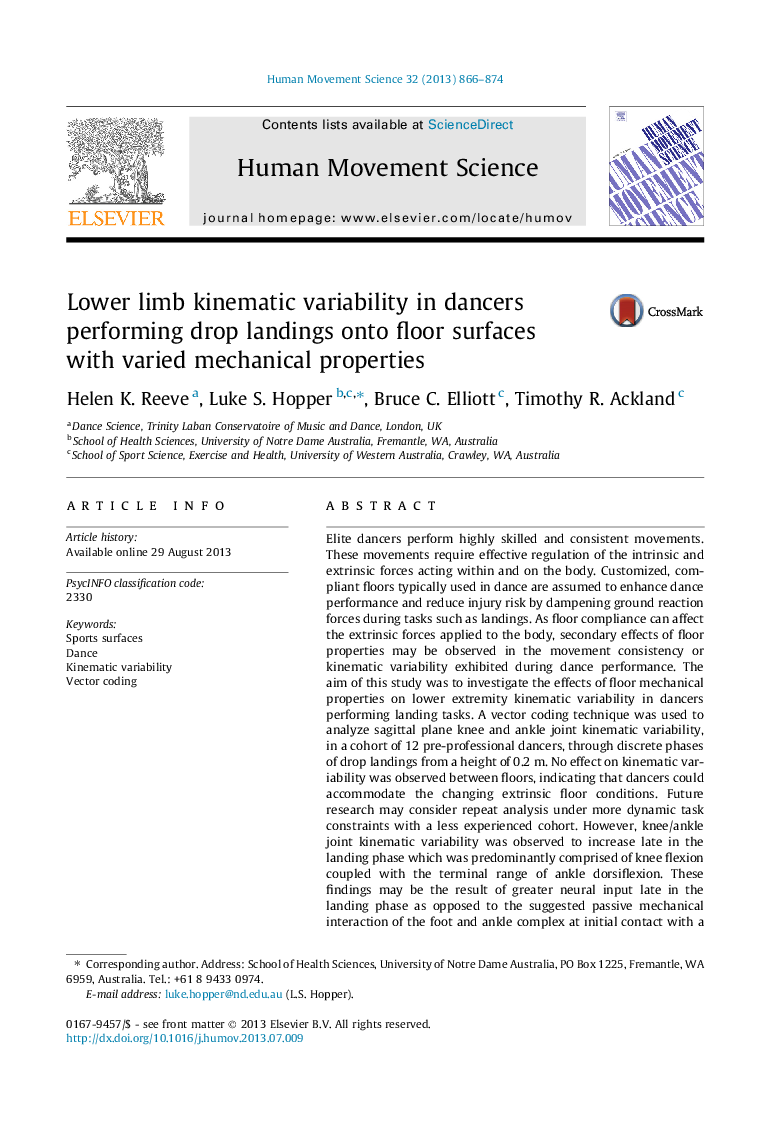| کد مقاله | کد نشریه | سال انتشار | مقاله انگلیسی | نسخه تمام متن |
|---|---|---|---|---|
| 10459211 | 922368 | 2013 | 9 صفحه PDF | دانلود رایگان |
عنوان انگلیسی مقاله ISI
Lower limb kinematic variability in dancers performing drop landings onto floor surfaces with varied mechanical properties
ترجمه فارسی عنوان
تنوع سینماتیک اندام پایین در رقصنده هایی که سقوط فرود را روی سطوح کف با خواص مکانیکی متنوع انجام می دهند
دانلود مقاله + سفارش ترجمه
دانلود مقاله ISI انگلیسی
رایگان برای ایرانیان
موضوعات مرتبط
علوم زیستی و بیوفناوری
علم عصب شناسی
علوم اعصاب شناختی
چکیده انگلیسی
Elite dancers perform highly skilled and consistent movements. These movements require effective regulation of the intrinsic and extrinsic forces acting within and on the body. Customized, compliant floors typically used in dance are assumed to enhance dance performance and reduce injury risk by dampening ground reaction forces during tasks such as landings. As floor compliance can affect the extrinsic forces applied to the body, secondary effects of floor properties may be observed in the movement consistency or kinematic variability exhibited during dance performance. The aim of this study was to investigate the effects of floor mechanical properties on lower extremity kinematic variability in dancers performing landing tasks. A vector coding technique was used to analyze sagittal plane knee and ankle joint kinematic variability, in a cohort of 12 pre-professional dancers, through discrete phases of drop landings from a height of 0.2Â m. No effect on kinematic variability was observed between floors, indicating that dancers could accommodate the changing extrinsic floor conditions. Future research may consider repeat analysis under more dynamic task constraints with a less experienced cohort. However, knee/ankle joint kinematic variability was observed to increase late in the landing phase which was predominantly comprised of knee flexion coupled with the terminal range of ankle dorsiflexion. These findings may be the result of greater neural input late in the landing phase as opposed to the suggested passive mechanical interaction of the foot and ankle complex at initial contact with a floor. Analysis of joint coordination in discrete movement phases may be of benefit in identifying intrinsic sources of variability in dynamic tasks that involve multiple movement phases.
ناشر
Database: Elsevier - ScienceDirect (ساینس دایرکت)
Journal: Human Movement Science - Volume 32, Issue 4, August 2013, Pages 866-874
Journal: Human Movement Science - Volume 32, Issue 4, August 2013, Pages 866-874
نویسندگان
Helen K. Reeve, Luke S. Hopper, Bruce C. Elliott, Timothy R. Ackland,
